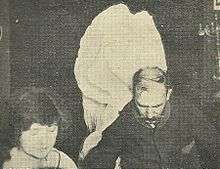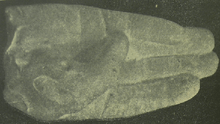Franek Kluski
Franek Kluski, real name Teofil Modrzejewski (1873-1943), was a Polish medium.


Career

Kluski was born in Warsaw. According to French psychical researcher Gustav Geley, Kluski's claimed psychic powers manifested themselves during childhood and after undergoing a psychological change he became Franek Kluski. Kluski's powers during séances were said to include physical manifestation of human limbs and various animals.[1]
Between 8 November and 31 December 1920, Geley of the Institute Metapsychique International attended fourteen séances with Kluski in Paris. A bowl of hot paraffin was placed in the room and according to Kluski spirits dipped their limbs into the paraffin and then into a bath of water to materialize. Three other series of séances were held in Warsaw in Kluski's own apartment, these took place over a period of three years. Kluski was not searched in any of the séances. Photographs of the moulds were obtained during the four series of experiments and were published by Geley in 1924.[2] Skeptics have pointed out that the experiments were not conducted in fraud proof conditions and the moulds could have easily been produced by fraudulent techniques.[3]
Geley has been described as an unreliable investigator. Physician Antônio da Silva Mello noted that Geley "published many writings on ectoplasms and teleplastic phenomena, things which today are quite out of date and totally discredited."[4] Magicians have been able to easily replicate the "materialization" moulds.[5] The magician Carlos María de Heredia revealed how fake materialization hands could be made by using a rubber glove, paraffin and a jar of cold water.[6]
Geley and Arthur Conan Doyle objected to the medium having used a rubber glove. In response, Harry Houdini demonstrated that a glove was not needed as he replicated the Kluski materialization moulds by using his hands and a bowl of hot paraffin.[7]
Harry Price wrote regarding Kluski "His mediumship is unsatisfactory from the point of view that no scientific body has investigated the alleged miracles. On each of my two visits to Warsaw I attempted to obtain sittings with Kluski, without results."[8] Researchers have compared Kluski's mediumship to the medium Eva Carrière and have speculated that he introduced items in the séance room by fraud.[9] A psychical researcher sent a letter to Hereward Carrington claiming Kluski had been detected in fraud.[10]
Massimo Polidoro and Luigi Garlaschelli have produced wax-moulds directly from one's hand which were exactly the same copies as Geley obtained from Kluski, which are kept at the Institute Metapsychique International.[3]
Fraud incident
In a notable incident during a séance that Paul Heuze attended the medium was requested to produce a face impression. However, a large-sized buttocks impression was found in the wax.[11] It was alleged by a séance sitter that "Kluski dropped... his pants and placed his buttocks in the paraffin".[12]
Heuze believed the impression was Kluski's. This was later confirmed as it was discovered that Kluski had suffered from a burnt buttocks for many days after the incident.[11]
Confession
Some later authors have written about an alleged confession from Kluski. In his book Sixty Years of Psychical Research (1950), magician Joseph Rinn claimed that Kluski had confessed to fraud.[13]
In 1978, researcher Melvin Harris also noted that Kluski had confessed to fraud.[14]
References
- Geley, Gustav; Brath, Stanley De. (2003). Clairvoyance and Materialization. Kessinger Publishing. ISBN 978-0766163140
- Chéroux, Clément. (2005). The Perfect Medium: Photography and the Occult. Yale University Press. p. 268. ISBN 978-0300111361
- Polidoro, Massimo. (2003). Secrets of the Psychics: Investigating Paranormal Claims. Prometheus Books. pp. 168-176. ISBN 978-1591020868
- Mello, Antônio da Silva. (1960). Mysteries and Realities of This World and the Next. Weidenfeld & Nicolson. p. 291
- Lycett, Andrew. (2007). The Man Who Created Sherlock Holmes: The Life and Times of Sir Arthur Conan Doyle. Free Press. p. 433. ISBN 978-0743275231
- Heredia, Carlos María De. (1923). Spirit Hands, "ectoplasm," and Rubber Gloves. Popular Mechanics. pp. 14-15
- Polidoro, Massimo. (2001). Final Séance: The Strange Friendship Between Houdini and Conan Doyle. Prometheus Books. pp. 71-73. ISBN 978-1573928960 "At the time Houdini didn't press the argument further, but later on, experimenting with paraffin, he found no artifice was needed to duplicate Kluski's moulds. As a series of pictures for a newspaper of the time shows, he immersed his hand in the hot paraffin, let it dry, and then carefully removed the hand from it. When one experiments with this technique, one realizes that it is not the plaster cast that has to be removed from the thin wax mould, which would be impossible to do without breaking the mould. One almost forgets that what has to be removed is the living hand, possibly the best-suited object to slip out of a mould without damaging it. In fact, a real hand is even more effective than any other artifice dreamed up to substitute for it. First, the paraffin doesn't stick to skin, only to quite long hair. Nonetheless, if one moves the fingers very slowly, one will realize that every small bit one pulls out will gradually allow the rest of the hand to be removed; that's similar to what happens when one pulls off a tight glove."
- Price, Harry. (2003). Fifty Years of Psychical Research. Kessinger Publishing. ISBN 978-0766142428
- Franklyn, Julian. (2003). A Survey of the Occult. p. 381. Kessinger Publishing. ISBN 978-0766130074
- Carrington, Hereward. (1988). Letters to Hereward Carrington from Famous Psychical Researchers. Society of Metaphysicians. p. 89. ISBN 978-1852287986
- Mello, Antônio da Silva. (1960). Mysteries and Realities of This World and the Next. Weidenfeld & Nicolson. p. 408
- Brower, M. Brady. (2010). Unruly Spirits: The Science of Psychic Phenomena in Modern France. University of Illinois Press. p. 171. ISBN 978-0252077517
- Rinn, Joseph. (1950). Sixty Years of Psychical Research: Houdini and I Among the Spiritualists. Truth Seeker Company. p. 441. "The medium Kluski produced a paraffin hand of a spirit for Dr. Geley, but when Dr. Geley wanted to bring him to the United States, Kluski confessed he was a fraud."
- Harris, Melvin. (1978). Strange to Relate. Granada Publishing. p. 102. ISBN 0-583-30342-0 "Doyle was also duped by Kluski, a medium who produced wax moulds, said to be made by 'spirit hands'! Yet Kluski later admitted that he was just a cunning trickster."
Further reading
- Hereward Carrington. (1907). The Physical Phenomena of Spiritualism. Herbert B. Turner & Co. pp. 224–229 reveals the "Paraffine Mould Test" trick mediums used.
- Michael Coleman. (1994). Wax moulds of ‘spirit’ limbs. Journal of the Society for Psychical Research. Volume 59: 340-346.
- Michael Coleman. (1994) The Kluski moulds: a reply. Journal of the Society for Psychical Research. Volume 60: 98-103.
- Massimo Polidoro, Luigi Garlaschelli. (1997). Spirit Moulds: A Practical Experiment. Journal of the Society for Psychical Research. Volume 62: 58-63.
- Zofia Weaver. (2015). Other Realities?: The Enigma of Franek Kluski's Mediumship. White Crow Books.
External links
- Harry Houdini Exposes Fraud (Houdini making hand moulds)